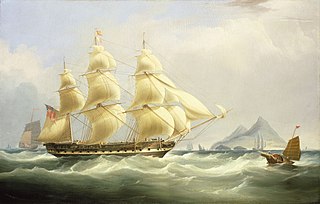Related Research Articles
HMS Albemarle was a 28-gun sixth rate frigate of the Royal Navy. She had been built as the French merchantman Ménagère, which the French Navy purchased in 1779. A British squadron captured her in September and she was commissioned into service with the Royal Navy. Amongst her commanders in her short career was Captain Horatio Nelson, who would later win several famous victories over the French. The Navy sold her in 1784. She subsequently became a merchant vessel again. In 1791 she transported convicts to Port Jackson as part of the third fleet. She then sailed to India where she picked up a cargo on behalf of the British East India Company. As she was returning to England a French privateer captured her.
HMS Squirrel was a Royal Navy sixth rate post ship, built in 1755. She served during the French and Indian War, most notably at Louisbourg and Quebec, and the American Revolution, during which she captured two French privateers. The Royal Navy sold her in 1783. J. Montgomery purchased her and she became the Greenland whaler Union. Then in 1790–91 she became a slaver, making five slave-trading voyages. Between 1796 and 1802 she made two voyages for the British East India Company (EIC). She then traded between London and Liverpool. She was last listed in 1804.
A number of sailing ships have been named Ocean.
A number of ships have been named Friendship:
Numerous ships with the name Phoenix, for the constellation or the mythical bird, have sailed for the British East India Company (EIC) between 1680 and 1821:

Six vessels with the name Royal George made voyages for the British East India Company, and so may be referred to as East Indiamen. The company actually owned one, four were on long-term charter, and one was a one-voyage charter. The vessels were named in honour of one or more of the British kings whose name was George.
Three ships with the name Osterley served the British East India Company (EIC) as an East Indiaman between 1758 and 1800:
At least four ships that have borne the name Triton, named for Triton, have made voyages for the British East India Company (EIC):

A number of ships with the name Asia served the British East India Company (EIC) as East Indiamen:
A number of ships with the name Essex served the British East India Company (EIC) as East Indiamen:
Numerous British vessels that have served the British East India Company (EIC) have borne the name Prince of Wales, after the then current Prince of Wales, the title borne by the heir-presumptive to the throne of the United Kingdom.
Several ships have been named Northumberland after the English county of Northumberland, or the Dukedom of Northumberland:
Several ships have borne the name Caledonia for Caledonia:
Orient was launched in 1814 at Calcutta. She sailed to England and from then on was based there. She traded with India into the 1830s. She participated in a naval punitive expedition in 1819, and performed four voyages for the British East India Company. From the 1840s she continued to sail widely until she was condemned in 1865 and sold for breaking up.
Lord Forbes was launched at Chester in 1803 as a West Indiaman. She soon became an "armed defense ship", but by 1805 had returned to being a West Indiaman. She made two voyages as an "extra" ship for the British East India Company (EIC). She continued trading with India until 1817 when she sustained damage on her way to Bengal. There she was surveyed, condemned and sold.

HMS Terror was an 8-gun bomb ketch launched in 1759 for the British Royal Navy that it sold in 1774. New owners renamed her Union. She made two voyages as a Greenland whaler before becoming a London-based transport. She remained a transport until she was lost on 20 May 1782 off the Malabar coast of India.
Tartar was built in France in 1778, almost surely under another name. She was taken in prize and appears under British ownership in 1780. After a short career as a privateer, she made a voyage between 1781 and 1783 as an extra East Indiaman for the British East India Company (EIC). She then became a whaler in the northern whale fishery. After whaling she traded with the Baltic and then served as a London-based transport. She was probably lost in 1799, and was last listed in 1801. If Tartar is the vessel lost in 1799, in 1796 French warships captured her, but the Royal Navy quickly recaptured her.
Several sailing vessels have been named Indus, after the Indus River, or the constellation Indus:
Glatton was launched as an East Indiaman. She made four voyages for the British East India Company (EIC) before her owners sold her in 1772. Her new owner, James Mather, renamed her Lord Howe and first deployed her to bring timber from North America to England. Mather then hired her out as a transport. She was last listed in 1782 and was probably the "ordinance storeship Lord Howe" that foundered in that year.
Grenville was launched at Deptford in 1764 as an East Indiaman. She made four voyages for the British East India Company (EIC) before her owners sold her in 1777 to the Royal Navy, which renamed her HMS Tortoise and employed her as a transport. She foundered in 1779.
References
- Hackman, Rowan (2001). Ships of the East India Company. Gravesend, Kent: World Ship Society. ISBN 0-905617-96-7.